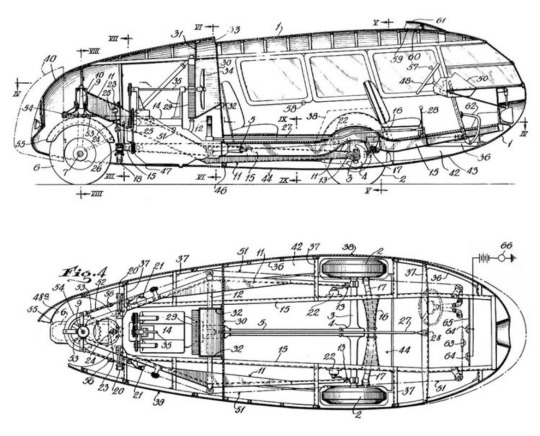#Dymaxion car
Explore tagged Tumblr posts
Text
A Tadpole on Wheels
Above: British architect Norman Foster's 2010 recreation of R. Buckminster Fuller's 1933 Dymaxion car. (Wikipedia) Despite the limitations of 1930s technology, a few architects and designers were hell-bent on building a streamlined future that until then was mostly the stuff of movies and science fiction magazines. May 5, 1934 cover by Rea Irvin. One of them was R. Buckminster Fuller (1895–1983),…

View On WordPress
#20th Century 1934#Barbara Shermund#Burlington Zephyr#Carl Rose#Charles Addams#Cornelius Vanderbilt Jr#Daniel &039;Alain&039; Brustlein#Dymaxion car#E.B. White#Eli Garson#Gardner Rea#George F. T. Ryall#George Price#Hitler&039;s Reign of Terror 1934#James Thurber#John Barrymore#John Dillinger#John Mosher#Kentucky Derby 1934#Leonard Dove#Norman Foster#Perry Barlow#Peter Arno#R. Buckminster Fuller#Whitney Bourne#William Steig
3 notes
·
View notes
Text

1938 Dymaxion
A car of the future, a rocket ship on wheels. The 1938 Dymaxion was designed by American inventor Buckminster Fuller during the great depression as a vehicle that might one day fly, land and drive.
98 notes
·
View notes
Text
get a load of the inferior:

if that doesn't scream 1970s
though my first thought was Buckminster Fuller's 1933 Dymaxion:

but the machine in the original post was based on the 1930s Airomobile, another fledgling idea that never took flight

1974 Fascination 2-Door Concept
135 notes
·
View notes
Photo

Dymaxion Car under construction in Bridgeport, Connecticut, 1933
86 notes
·
View notes
Text

Alternative Sleep Schedules
Polyphasic sleep refers to sleeping in more than two segments per day. Following a polyphasic sleep pattern doesn't necessarily reduce the total number of hours you sleep, but many people adopt polyphasic sleep as a way to reduce their overall sleep time and maximize their wakeful hours.
.
Studies have shown that a polyphasic sleep pattern can fight the negative effects of sleep deprivation by allowing for short naps throughout the day. These naps replenish lost nighttime sleep as well as boost brain function. Polyphasic sleep has also been found to increase alertness.
.
To understand polyphasic sleep, it's important to understand our culture's current ideal for optimum rejuvenation. The traditional eight hours of shuteye we hear about most often today is referred to as monophasic sleep - just one sleep session and then you're awake for the day.
.
Conversely, polyphasic sleep is about segmenting your slumber into multiple phases. Different sleep schedules such as Biphasic, Dymaxion, Everyman, and Uberman each consist of several naps and/or core sleep sessions (deep sleep and REM) a day.
Biphasic: Consists of a split sleep schedule with two sessions. Often a five to six hour "core sleep" and then a one and a half hour nap.
Dymaxion: Commonly consists of four 30-minute naps during the day. Two hours of sleep total.
Uberman: Usually consists of six to eight 20-minute naps during the day. Generally, two hours of sleep total.
Everyman: Commonly consists of four sleep sessions. Often a three to four hour core sleep followed by three naps throughout the day.
.
Historical Sleep Patterns
Now labeled as an "alternative" sleep schedule, polyphasic sleep was once the norm.
The dominant pattern of sleep, arguably since time immemorial, was biphasic... Humans slept in two four-hour blocks, which were separated by a period of wakefulness in the middle of the night.
.
These weren't brief phases either. Many times people would actually get up and take on their daily (or in some cases nightly) tasks, visit with neighbors, talk with their family, etc. Sleep schedules changed drastically as the Industrial Revolution brought forth an artificial sense of extended daylight with the advent of the light bulb. Too much bright light stops our bodies from releasing melatonin, a hormone responsible for regulating sleep.
.
Some famous advocates of polyphasic sleep, were Leonardo da Vinci, Thomas Edison, and Nikola Tesla. Both da Vinci and Tesla followed the extreme polyphasic Uberman method, requiring only 2 hours of sleep a day, segmented into 20-minute naps.
Salvador Dali, had his own sleep method. He would sit with a key in one hand, poised above a metal plate placed on the floor, and let sleep take him. As soon as he began to slumber in earnest, the key would slip from his fingers and clang against the plate – waking him immediately. Dali felt as though sleep was a waste of time.
.
Around 85% of mammalian species are polyphasic sleepers.
Ultimately, the vast majority of people are not built to sleep in patterns other than monophasic or biphasic sleep schedules. Biphasic sleep, which deviates the least from the contemporary eight-hour model, has been shown to have some significant benefits. Anecdotal evidence seems to indicate that biphasic sleep can actually maximize creativity and alertness in highly innovative individuals. It is now suspected that the creative genius of historical figures such as Tesla or da Vinci, who were said to have ascribed to the "Uberman" model, actually may have been caused by mania or insomnia.
.
Possible Dangers of Polyphasic Sleep
Significant hormone imbalance (especially in young adult males)
Lower cognitive functioning
Trouble operating cars or heavy machinery
.
Naps are Still Good
If you take a nap during the day, don't worry. Naps are safe, healthy, and sometimes all you need to stave off your sluggishness. A study on sleepy military pilots and astronauts found that a 40-minute nap improved performance by 34% and alertness 100%. In addition to performance, a short session of shuteye can help with:
Alertness
Relaxation
Physical rejuvenation
Stress
Tension
Depression
Research found that only 5% of the population can get by on just six hours of sleep. Regardless of which sleep schedule you choose, the importance of good sleep cannot be underestimated.
7 notes
·
View notes
Text
This streamlined Dymaxion car was designed by the American inventor Buckminster Fuller during the Great Depression and was featured prominently at the Chicago worlds fair in 1933-1934.
Fuller built three experimental prototypes with naval architect Starling Burgess using donated money as well as an inheritance.
Not as an automobile, per say, but as a vehicle that one day might be designed to fly, land, and drive.

24 notes
·
View notes
Text
The Dymaxion was a delicate woodland creature

That would rip your throat out if you actually tried to drive it

Fuller noted severe limitations in its handling, especially at high speed or in high wind, due to its rear-wheel steering (highly unsuitable for anything but low speeds) and the limited understanding of the effects of lift and turbulence on automobile bodies in that era – allowing only trained staff to drive the car and saying it "was an invention that could not be made available to the general public without considerable improvements."[9] Shortly after its launch, a prototype crashed and killed the Dymaxion's driver.
Morning comrades who wants to see some wacky art deco vehicles
26K notes
·
View notes
Video
youtube
1933 Dymaxion Car: A Blimp on Wheels That Could've Changed the Future
0 notes
Text
Is that a Dymaxion model I've never seen, or did someone else do three-wheel cars as well?

607 notes
·
View notes
Text


The Dymaxion car was designed by American inventor Buckminster Fuller during the Great Depression and featured prominently at Chicago's 1933/1934 World's Fair. Fuller built three experimental prototypes with naval architect Starling Burgess – using donated money as well as a family inheritance – to explore not an automobile per se, but the 'ground-taxiing phase' of a vehicle that might one day be designed to fly, land and drive – an "Omni-Medium Transport". Fuller associated the word Dymaxion with much of his work, a portmanteau of the words dynamic, maximum, and tension, to summarize his goal to do more with less.
youtube



12 notes
·
View notes
Photo

Buckminster Fuller’s Dymaxion Car
171 notes
·
View notes
Text

Dymaxion
34 notes
·
View notes
Text

1938 Dymaxion designed by Buckminster Fuller
24 notes
·
View notes

